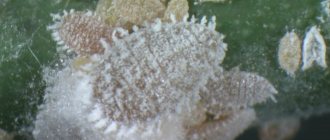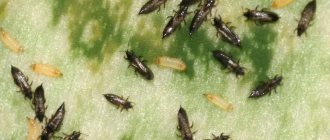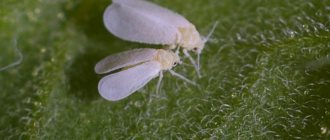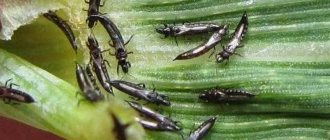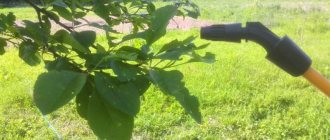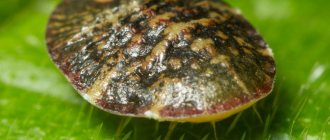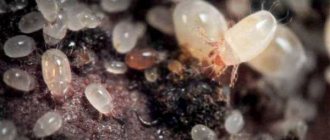Amateur plant growers often encounter such a misfortune as the appearance of a white coating on house plants. It can appear as local spots on leaf blades or petioles, or cover the plant and soil in the pot with a continuous fluffy “carpet”. In fact, an indoor flower can be attacked by various pests: from mold to parasitic insects.
Timely recognition of the causative agent of the disease and proper treatment will save the plant and prevent others from becoming infected.
Features of the disease
White plaque on indoor plants can be caused by various pathogens, but certain conditions are required for their appearance. The fungus in the form of white mold develops:
- with a combination of low temperature (10-15 °C) or temperature fluctuations in the apartment and high humidity;
- stagnation of water in a pot or tray;
- excess nitrogen compounds in the soil.
Insect pests and their larvae enter plants from contaminated soil. Often the source of infection is a new ornamental seedling affected by the pest.
Important! Any plant can get sick, since the spores of pathogenic fungi and the eggs of insect pests are microscopic in size and are carried by air flow or flying insects.
Septoria
Septoria
It is provoked by the activity of primitive fungi of the genus Septoria, which affect phlox, anthurium and many garden crops. The causes of the development of the disease are waterlogged soil and watering with cold water, which weakens the immune system and does not allow the plant to resist infection using the natural defenses of the plant.
Symptoms of the disease are small dark yellow spots, which over time spread along the leaf and lead to its drying out and natural falling. A characteristic feature is the pink iris that forms around the spots.
In treatment, only complex fungicidal preparations are used, since improvised means are ineffective in most cases.
Reasons for appearance
The cause of the appearance of a white coating on flowers may be infection with insect pests or pathogenic microflora:
- Powdery or downy mildew. A fungal disease spreads quickly among houseplants. With powdery mildew, a white fluffy coating appears on the front side of the leaf blades. In false cases, yellow-violet spots of irregular shape with a whitish coating on top (spores) form on the reverse side of the leaves. Reasons: excess nitrogen, calcium, overflow, high air temperature in the house.
- Mealybug. Pseudococcides or felt insects stick to the leaf blade, buds, roots and suck out nutritious juices, as a result of which growth and development slows down, the plant dries out and dies. A white coating similar to cotton wool is sacs containing parasite eggs. Insects also secrete honeydew, a sweet sticky sap on which pathogenic sooty fungus begins to multiply.
- Mold. Ectofungal spores grow into mycelium on the surface of leaves and shoots. The plant is covered with white fleecy veins of mycelium, on which “dust” – spores – is visible. More often, mold develops as a result of excessive moisture and temperature changes in the room.
- Gray rot. The fungal infection spreads throughout the plant. It looks like silver-gray fluff dusted with white flour.
Mealybug
Ascochyta blight
Ascochyta blight
The disease is caused by the activity of fungi of the genus Askochita, which are found in large quantities in the soil. It appears in cereals, pumpkins and even citrus fruits. As for flowers, asters and chrysanthemums are most honored by fungi. The reasons for the development are:
- waterlogging of the soil (improper watering, prolonged downpours);
- excess nitrogen in the soil;
- sudden changes in temperature;
- dense plantings.
Ascochyta blight manifests itself in the form of fading of part of the leaf blade (like a sunburn), which quickly spreads to other areas. A completely affected flower dries out, and characteristic rot is present on the roots.
If the disease has affected most of the plant, then, no matter how sad it may sound, you will have to get rid of it. Ascochyta leaves are removed, and spraying with fungicides is used to prevent the entire flower from wilting. The means at hand are practically powerless, so preference is given to Bordeaux mixture and Topaz.
Advice! After the main etching, it is necessary to do preventive etching after 10-14 days. This way the result will be consolidated and the remnants of the mycelium will completely die, which will prevent the development of new foci of infection.
Treatment of different types of plaque
If a white coating is found on indoor plants, it is necessary to begin the fight immediately. The way to resist the scourge will directly depend on the type of disease.
Mold
If mold appears on the surface of the soil, it can be mechanically collected and discarded. Wash off the white coating from the leaves with a cotton pad soaked in a soap solution. The plant can also be transplanted into a new, disinfected pot.
Chemical and biological fungicides are used to control fungal diseases such as mold.
- Fitosporin M , Baktofit SP, Agat 25K are preparations of biological (natural) origin.
- Diskor, Vitaros, Vectra, Oxychom are chemical fungicides.
According to the instructions on the package, prepare a working solution with which to spray the plant. Some compounds have a pungent odor, so it is better to carry out the treatment by taking the pot with the plant out into the fresh air.
Attention! To achieve results, you should follow the manufacturer’s recommendations for dosage and frequency of treatments.
Mealybug
As mentioned above, a sign of mealybugs appearing on indoor flowers is a white coating that looks like cotton wool. For the first stage of the fight, visible insects can be collected manually by washing off the white coating on the leaves and stems with a cotton pad with liquid soap or a solution of vegetable oil (1 tablespoon per glass of water). Then treat with pesticide. We can recommend:
- Confidant;
- Biotlin;
- Aktara;
- Mospilan;
- Fitoverm;
- Tanrek.
Advice! It is worth choosing drugs with systemic action. They not only spray the plantings, but also spill the soil. Toxins penetrate into all tissues of the seedling, and the mealybugs receive poison from the plant sap.
Aktara
Powdery mildew
Powdery mildew often affects indoor flowering plants:
- orchids;
- violets;
- geranium, etc.
To treat powdery plaque, experienced plant growers recommend folk remedies, since industrially produced fungicides can be aggressive and have a bad effect on the appearance of flowers.
- Lactic acid products, especially whey, are harmful to fungi. You can wipe the entire plant (stems, leaves, peduncles, buds and flowers) with a solution of 1 part whey (kefir, curdled milk) and 3 parts water every three days until the plaque disappears.
- An infusion of mustard powder (2 tablespoons per bucket of water) or an infusion of ash and laundry soap (200 g and 50 g per 10 l) is used for daily spraying and watering. You can alternate.
- To spray orchids and other flowers, you can use a solution of copper sulfate (1 tbsp) and liquid soap (1 tbsp) per 5 liters of clean water. Spray every other day for 2 weeks or longer until the fungus disappears.
Gray rot
It is necessary to combat such a serious fungal disease as gray mold in a comprehensive manner. First of all, all affected shoots and leaves are cut out. If there are more than 50% of them, it is better to get rid of the plant entirely. The danger of gray rot lies in its rapid transmission from one seedling to another.
In addition to the fungicides mentioned above, copper-based preparations are used to combat fungal diseases: Bordeaux mixture, copper sulfate. They spray the plants 3 times with a break of 7-14 days.
Gray rot
Chemicals
After treating with a soap solution, you can finish the fight with the help of chemicals. They act more effectively in May-July, when the females are still without protective shields. The best preparations for spraying: Fitoverm, Aktara (KS, VOP).
Processing stages
- After spraying with insecticide, the flower should be covered with a bag and left for 40 minutes.
- Then rinse the seedling in the shower to remove the chemical and dead individuals.
- After 2 weeks, repeat spraying to destroy hidden beetles.
- Check all indoor flowers regularly using a magnifying glass.
Efficiency of Aktara
"Aktara" is a new generation insecticide. It has characteristics such as high efficiency and versatility in use.
This drug is toxic, so all precautions must be taken when using it. It is especially dangerous to inhale the vapors of this product. While working, you must wear gloves, a protective mask and goggles.
If home vegetation is attacked by parasites, then “Aktara” will help cope with them.
"Aktara" is a fast-acting insecticide with enteric contact action. The product is available in granules and suspensions. Its substances have a detrimental effect on many insects.
Advantages of "Aktara":
- It has a high degree of absorption, so the drug is capable of destroying more than 100 types of pests;
- The impact on pests is rapid. After an hour, you can notice the death of the parasites;
- Plants can be treated at any time and in any weather;
- The drug can act for 1 to 2 months;
- Without accumulation effect, therefore does not harm crops.
Disadvantages of Aktara:
- Harmful to bees, wasps, hornets;
- It is not recommended to store in a diluted state.
Dilute the drug only according to the instructions. Treat only trunks, leaves and roots, avoiding flowers and ovaries. After treatment, the flowers should stand for 24 hours, preferably under a bag. Dilute the product only with warm water.
If pests have dug into the root zone, then watering with Aktara will help protect the entire plant. The root system will begin to promote the drug substances throughout all cells of the culture, and the parasites will quickly become saturated with poison.
“Aktara” will destroy their digestive tract, as a result the nerve endings of the parasite will be paralyzed, so the insect will no longer want to suck the juices from the plant. Without food it will soon die.
Preventive measures
The complex of preventive work consists of several parts:
- Attention to the soil.
- The top layer of potting soil should be changed every 3-6 months (to a depth of 2-4 cm).
- Plants must be replanted as they grow into a new, more spacious pot. The root system is examined at the same time. If there are signs of disease, the old soil should be removed (washed off), and the roots should be disinfected in a weak solution of potassium permanganate.
- Before replanting, the new soil should be disinfected (calcined, steamed, frozen), and the pots disinfected (rinsed with a solution of potassium permanganate, doused with boiling water).
- To improve aeration, it is important to mix potting soil with perlite and vermiculite.
- Sufficient amount of moisture.
- It is worth watering potted plants when the soil dries to a depth of 2.5-3 cm. Excessive watering leads to waterlogging, soil oxidation, and the development of fungal diseases and mold. From soil that is too dry, the plant cannot receive nutrients and dies.
- Sometimes watering can be replaced by loosening, which is popularly called “dry watering.”
- Periodically, it makes sense to spray the plants leaf by leaf, possibly with the use of foliar fertilizing (fertilizers, growth and immunity stimulants).
- Preventive use of biological or chemical control agents: spilling with a solution of Fitoverm, Aktary, etc.
- The most important thing is a careful and attentive attitude towards the indoor flowers themselves:
- correct agricultural technology for different species;
- periodic inspection;
- removal of dead, dry parts;
- washing plants;
- quarantine for “newcomers” to the home greenhouse.
Scab
Elena Stanislavskaya
I know everything and a little more about ornamental plants. I bring everything new and most interesting to life, creating unique landscape compositions and green oases in the house.
Ask a Question
This disease has collective symptoms and has its own pathogens for each plant species. It appears in the form of growths, tubercles or dents on fruits and trunks, which lead to deformation. Most often, potatoes, apples, pears, tomatoes, eggplants, peppers, and rosaceae are affected.
Scab
In the fight against scab, it is important to recognize it in a timely manner. If the slightest signs appear in the form of growths, preventive spraying should be carried out. You can choose a store-bought remedy for scab, which has a complex effect on the plant and prevents relapse. The available and safe options for combating the disease include the following:
- Spraying with mustard and ash - for 1 liter of hot water, take 1 tablespoon of mustard powder and 2 tablespoons of wood ash. Leave to brew for a day, then mix well and spray the entire above-ground part of the plant. The frequency of prevention is 4 times per season;
- Potassium permanganate and boric acid - for 1 liter of hot water, take no more than a match head of potassium permanganate powder and the same amount of boric acid powder. The result is a saturated purple solution, which is poured into a five-liter bucket, 1 tablespoon of iodine is added and flowers, shrubs and fruit trees are treated.
Scab treatment in spring is especially necessary for garden crops. Trees and shrubs should be sprayed with boiling water with the addition of 1 tablespoon of table salt per liter of water.
We create the right care
To get rid of white plaque, it is necessary to provide comprehensive care for the diseased plant. First you need to understand the agricultural technology of cultivation:
- Water the plant only when the top layer of soil begins to dry out.
- When treating a plant, you cannot spray it (with the exception of medicinal purposes). This also applies to healthy plants for preventive purposes.
- The flower needs more sunny days, it is advisable to move the flower to a dry and warm place, with little direct sunlight
- Withered and dry leaves and buds must be torn off
- With this disease, you cannot use any fertilizers or fertilizers.
Hide the plant from direct sunlight
Provide the plant with proper care, otherwise powdery mildew will become your regular visitor. Now let's move on to treating the disease.
